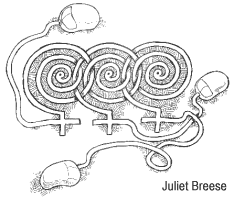Fall 97
Winter 98
Part 2
Part 3
Part 4
Part 5
Part 6
Part 7
Part 9
Part 10
Part 11
SITE MAP
ABOUT US
PAST ISSUES
LETTERS
SUBSCRIBE
COPYRIGHT
Clearinghouses:
Does bigger always mean better?

by Penney Kome
At the Womenís Internet Conference, several of the working groups recommended setting up ďclearinghousesĒ on the Web, for sharing information. But what exactly is a clearinghouse? The word originated with banks and merchants, who used central warehouses to exchange cheques and cash with one another, or to coordinate payment and delivery among manufacturer, wholesaler and retailer. Most websites are to some degree interactive. It doesnít necessarily mean that they are really centres for exchange, the way warehouses can be. Letís look at some sample sites.
One bare bones warehouse that Iíve been using regularly practically since I started on the Net is MEGASOURCES, a resource for journalists established by Dean Tudor of Ryerson Journalism School. MEGASOURCES is more functional than pretty, but itís clean and comprehensive. Here, in one spot, are links to phone directories, demographics, Internet tutorials, public opinion polls, WWW service providers around the globe, and corporate investigative services. At
www.ryerson.ca/~journal/megasources.html
it is one handy site for reference material. Is it a clearinghouse? Well, itís hard to see where thereís any "exchange" involved. Dean Tudor puts up the links and maintains them; others visit and go through them.
At the Ontario Prevention Clearinghouse, created in 1985 but put online more recently, defining what "clearinghouse" means has been an ongoing process, according to OPCís Alison Stirling. Her colleague Susan Ewing suggested that in a virtual clearinghouse, "the document listings are centralized, and provide direct links either to electronic copies of texts or contact databases, or links to ordering information..." Thatís pretty much how the OPC is set up, at
http://www.opc.on.ca/
Information about promoting health and preventing violence is available through links to the participating organizations. As a website, itís interesting, useful and attractive - but itís still developing the concept of what a clearinghouse might be.
Susan Ewing suggested ERIC might be the best-developed clearinghouse model on the Web. ERIC is the US Department of Education Clearinghouse of clearinghouses on education, and it is massive. In fact, all of the thirty clearinghouses linked to the ERIC site at
www.aspensys.com/eric
seem to be huge too. To help visitors find precisely the data they need, ERIC offers not one but two different search engines, and two autobot retrieval servers, called AskERIC and ParentsAskERIC, that field questions and call up relevant documents in the database. There are also links to listservs, for ongoing discussions. Thatís pretty interactive.
ERIC, in fact, seems to be the most advanced clearinghouse Iíve found. Of course, itís been in operation thirty years, in various forms. Whether it provides a model of what feminists would want from a clearinghouse is another matter. I wasnít able to find any full-developed feminist clearinghouse, as such, although there were a few contenders.
The Feminist Curricular Resources Clearinghouse at
www.law.indiana.edu/fcrc/fcrc.html
a site dedicated to resources related to teaching about feminism and law, might yet develop into a model site. Right now it offers a short list of resources, indexed by both author and subject, a search engine, and a discussion forum or BBS. Neat, but still a fledgling.
The Breast Cancer Information Clearinghouse at
nysernet.org/bcic
offers indexes, a search engine, and lists of hotlines and local breast cancer support groups ó another way to warm up the cool medium of the Internet by providing human contact.
The Sapient Health Network at
www.shn.net/
not only offers an autobot to respond to questionnaire forms by serving up archived documents on various health topics ó it also stores the questionnaires so they are available to SHN researchers who want to gather information on certain health topics. In other words, an inquiry on, say, menopause, may lead to a polite email invitation to participate in a survey about particular aspects of menopause. That kind of thoroughness might be a little bit too interactive for some.
For all the advantages of gathering as much information as possible into one site, clearinghouses can be overwhelming in the sheer volume of material they collect. Bigger is not necessarily better. Nor is bigness a goal of the feminist vision in any other aspect of information gathering or sharing. Indeed, women often face limited access to resources, and may start online with slow, low-tech equipment which would restrict new users to email or small websites.
Efficient, women-friendly search engines might prove just as useful for feminist research as the clearinghouse model. Easily accessible, affordable womenís networks might be another way to go. The clearinghouse model may well be adaptable to feminist philosophy ó and frankly, may be easier to find funding to build - but IMO, women need to think hard about what we expect to get from clearinghouses before we invest a lot of energy in building massive sites.
kome@shaw.wave.ca
| Top |
Part 1 |
Part 2 |
Part 3 |
Part 4 |
Part 5 |
Part 6 |
Part 7 |
Part 9 |
Part 10 |
Part 11 |
Home |